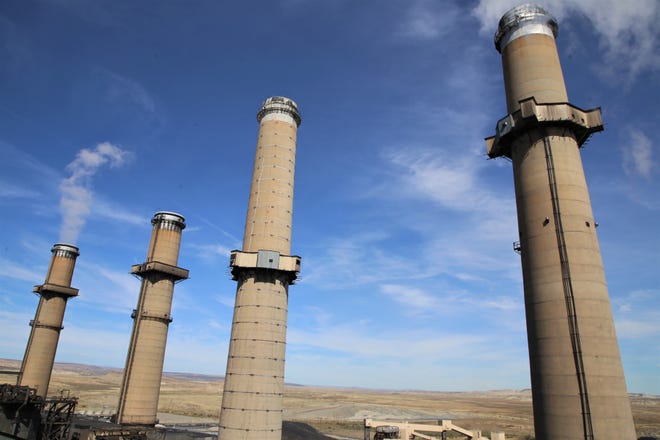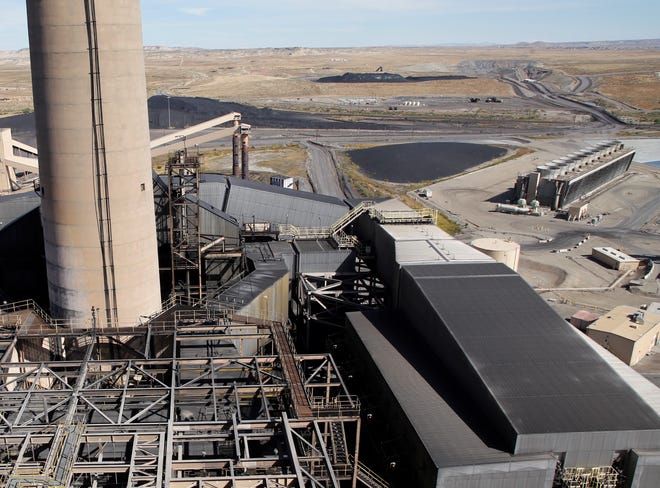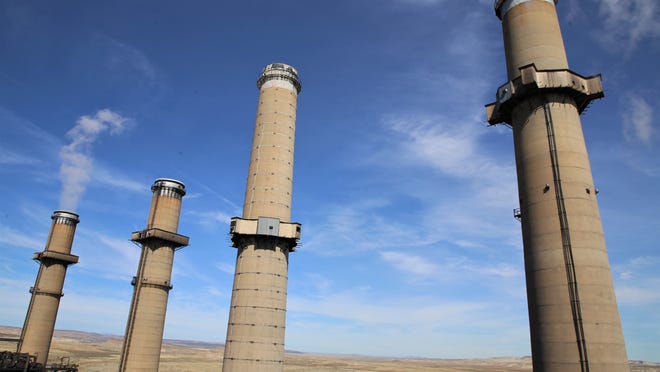After years of waiting, IRS and Treasury release guidance for carbon capture tax credit
PNM says new guidelines don't change its past analysis of carbon capture at the San Juan Generating Station
FARMINGTON — The proposal to retrofit the San Juan Generating Station with carbon capture technology and keep it open after 2022 relies heavily on tax equity financing, but there has not been any guidance for how the 45Q tax credits will work.
That changed this week when the U.S. Department of Treasury and the Internal Revenue Service issued two draft guidance documents.
The 45Q tax credits were initially established under President Barack Obama's administration in 2008 and later enhanced in 2018 to promote the development of carbon capture projects throughout the United States.
Enchant Energy has proposed using the tax credits that will be generated by removing carbon dioxide from flue gas at the power plant to attract investors.
News Navajo Nation, San Juan County officials say partnership could make railroad a reality
Chief Operating Officer Peter Mandelstam said the draft guidance documents appear to be based on successful tax credits that spurred the development of wind and solar projects.
“Our lawyers felt that it was very straightforward with no surprises,” he said.
Public Service Company of New Mexico stated in a press release that it didn't find any surprises in the guidance either and, after reviewing the guidelines, it calculated that it would be more expensive for PNM to retrofit the power plant with carbon capture than it would be to close the power plant and replace it with natural gas and renewable energy.

“We do not doubt that carbon capture works in a laboratory setting," PNM Vice President of Generation Tom Fallgren said. "Our challenges are to make it work cost-effectively at the scale of the San Juan Generating Station. These challenges become even more difficult when you are working to reach the statutory mandate of 80% renewables with coal resources that limit the full use of renewables. We understand the benefit of this technology could potentially provide to help fight climate change, but PNM has an obligation to its customers to provide reliable, affordable and environmentally responsible energy. PNM continues to see significant concerns that could expose PNM customers to significant costs and potential system reliability concerns with this technology. Nothing in the guidelines issued from the IRS on Wednesday changes our financial analysis.”
New Mexico legislative session roundup:'Red flag laws' create a stir; rally planned
In an infographic included in the press release, PNM stated that coal is more expensive and carbon capture requires additional water. In addition, the carbon capture units will require about 29% of the power produced to operate.
Enchant Energy plans to make the carbon capture units the baseload electric customer for the power plant and, unlike PNM, Enchant Energy will not be regulated by the New Mexico Public Regulation Commission. That means it will not be subject to the 80% renewable energy mandate, although it will have to meet state emission guidelines.
Enchant Energy has maintained that while carbon capture may not make sense for an investor-owned utility like PNM, it can be a successful enterprise for a merchant utility. Merchant utilities sell the electricity they generate on the market rather than directly to homes and businesses.

Mandelstam said having the tax credit guidance in place gives investors the confidence to fund carbon capture projects.
But Karl Cates, transition policy analyst for Institute for Energy Economics and Financial Analysis, disagreed. IEEFA is a non-profit advocacy organization focused on renewable energy development. It has been critical of carbon capture proposals for coal-fired generation.
"It's not the best news for the project because it only gets them half way where they need to be in terms of assuring investors that the project can actually work," Cates said.
He said the guidelines don't offer all the clarity investors will need and Enchant Energy must also compete with the fact that coal-fired power plants are not attractive investments.
News:IEEFA analyst says San Juan Generating Station proposal based on faulty assumptions
Cates said the guidelines could provide the clarity and assurance needed for smaller projects, such as carbon capture on cement manufacturing plants.
But, in terms of coal-fired power plants, Cates said there is not enough clarity in the tax credit policy to attract investors.
To access the tax credit, the project must be under construction by Dec. 31, 2023.
Mandelstam said he does not anticipate any problems meeting that deadline. In fact, Enchant Energy hopes to break ground on the project next year, pending an agreement with the current and past owners of the power plant.
If, for some reason, the project construction had not begun by deadline, the guidance includes a five-percent safe harbor provision. That means the project will still be eligible for the tax credits as long as the developers have paid five-percent of the total cost of the project by that deadline. The five-percent safe harbor includes studies like the front-end engineering and design study that is currently underway.

The provision also includes guidance on what happens if there is a cost overrun that prevents Enchant Energy from meeting that five-percent safe harbor provision. If that occurs, a portion of the project could still qualify for the tax credit. For example, two of the three planned carbon capture units could be eligible.
But Mandelstam does not anticipate that the safe-harbor provision will be needed for the retrofit because Enchant Energy plans to complete the project before Dec. 31, 2023.
He said subsequent carbon capture projects may rely more on the provision.
“We’ll probably be the first and earliest,” Mandelstam said.
Looking forward: PNM official talks next steps as utility looks to end SJGS operations
The draft guidance also includes a provision addressing potential lawsuits against developers from Enchant Energy intended to “run out the clock,” Mandelstam said.
Carbon capture projects can be controversial and opponents say they promote the continued reliance on fossil fuels, especially if the carbon dioxide captured is used in enhanced-oil recovery.
In an infographic, PNM stated that carbon capture could lead to a net increase of carbon dioxide emissions if used for enhanced-oil recovery. In addition, sale of power from the San Juan Generating Station will compete with renewable sources for transmission, the press release states in an infographic.
The tax credits will be available for 12 years and, if the project is successful, Enchant Energy has committed to keeping the power plant open through 2035.

Mandelstam said Enchant Energy could choose, based on stakeholder input, to keep it operating through 2053.
“That’s not something we’re going to decide today,” he said.
However, that decision will be made before Enchant Energy files the necessary permits to operate the facility.
While the guidance provides assurance for investors, Mandelstam said more guidance is still needed. He said Enchant Energy is still waiting for guidance about what will be considered geologic storage. Placing carbon dioxide in geologic storage means access to higher tax credits, but would also mean foregoing revenue from the sale of carbon dioxide.
The new guidance also does not define which uses of captured carbon dioxide will be eligible for the tax credit.

Hannah Grover covers government for The Daily Times. She can be reached at 505-564-4652 or via email at hgrover@daily-times.com.
Support local journalism with a digital subscription: http://bit.ly/2I6TU0e